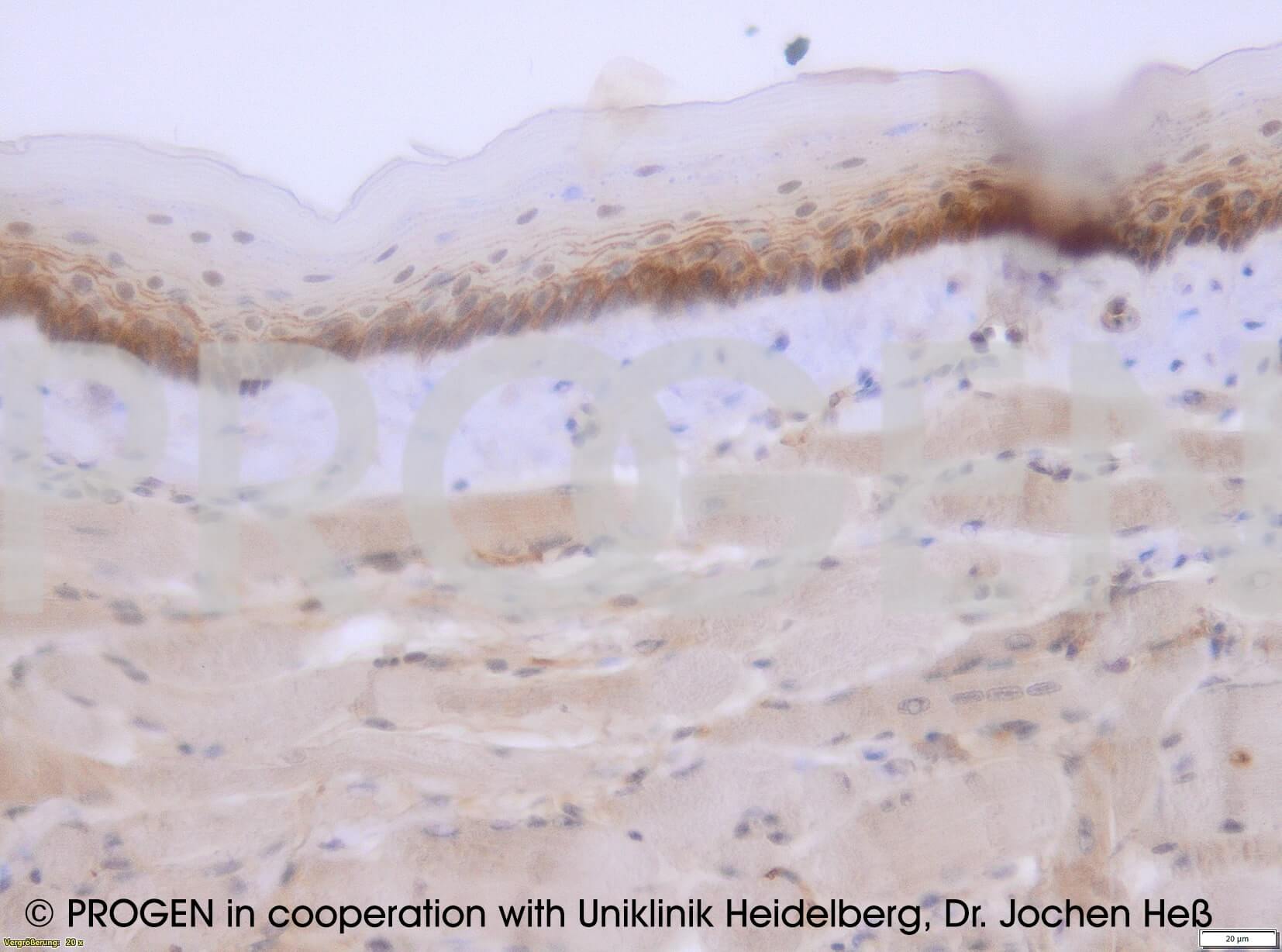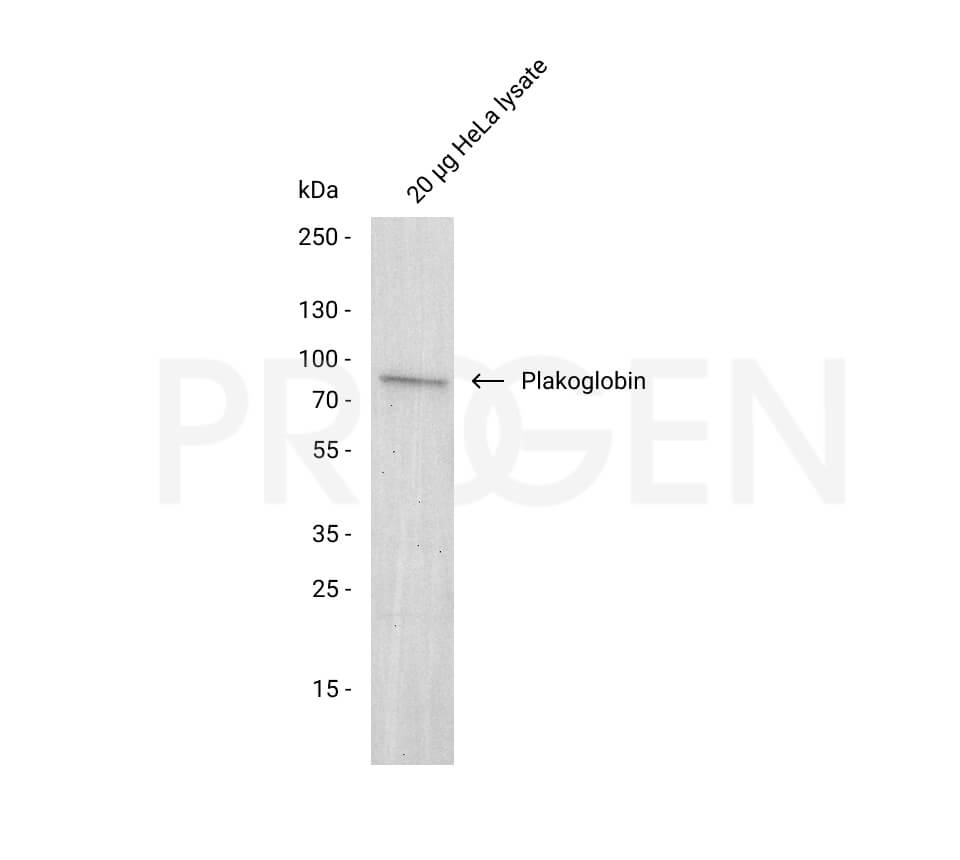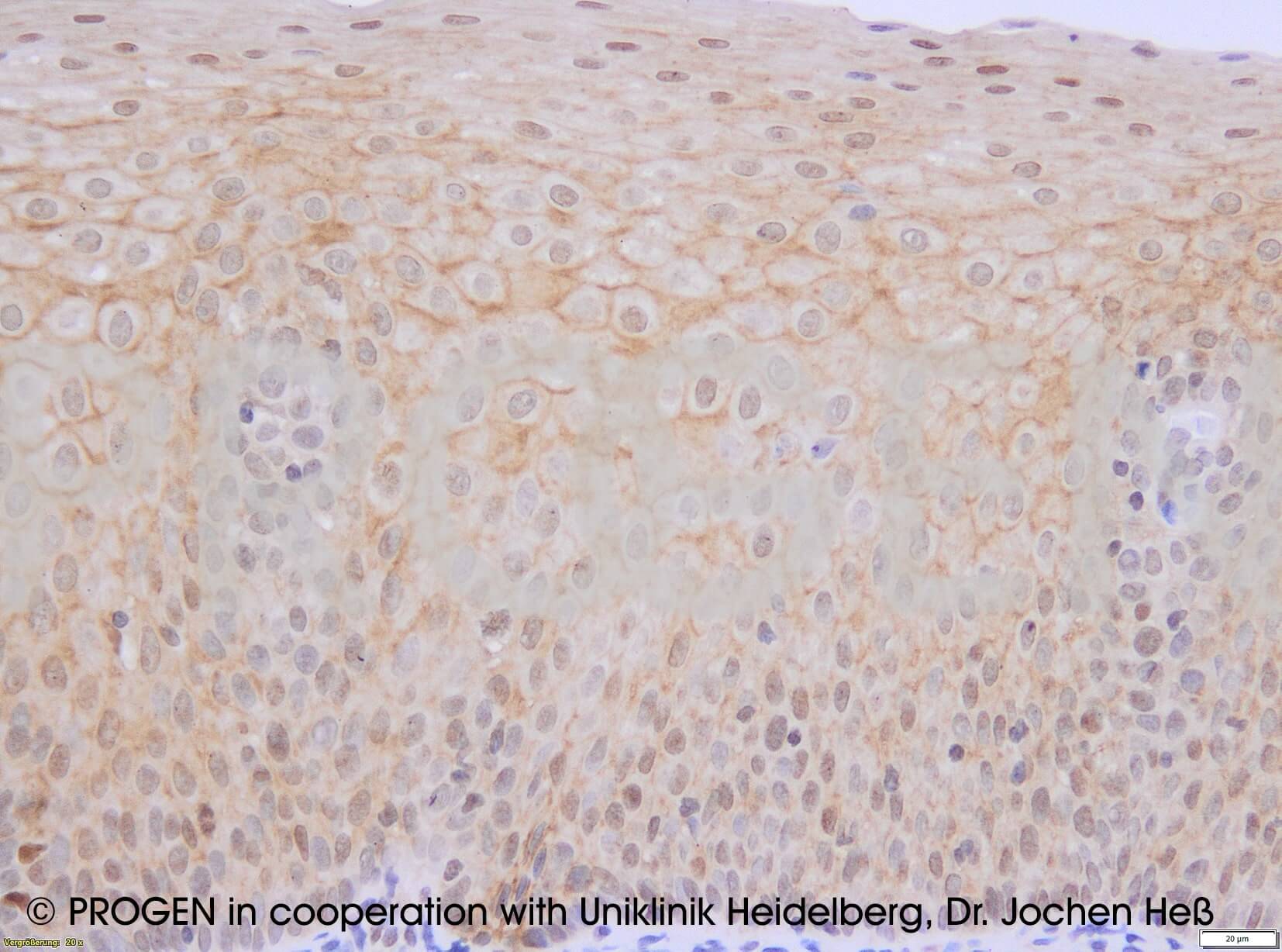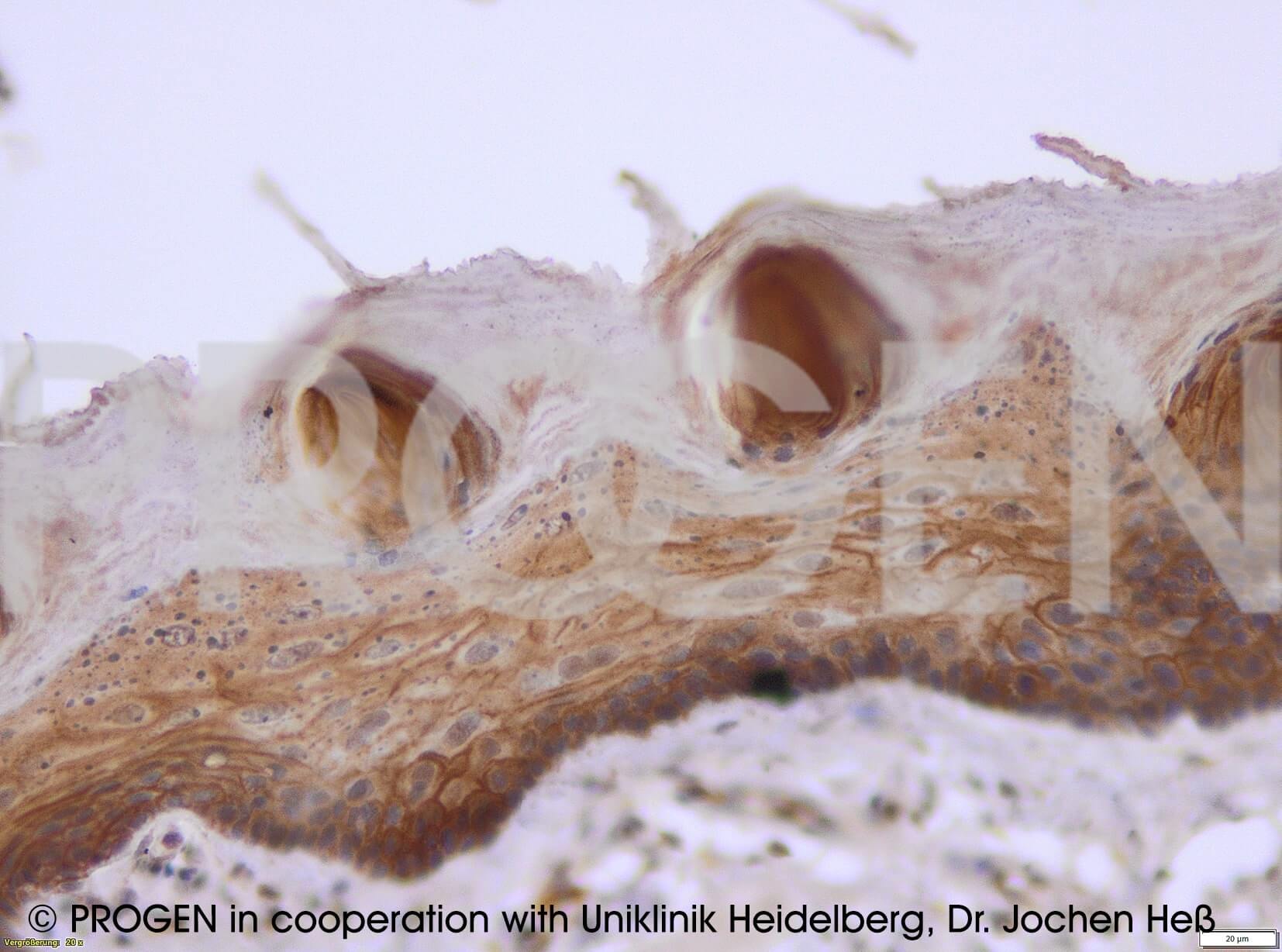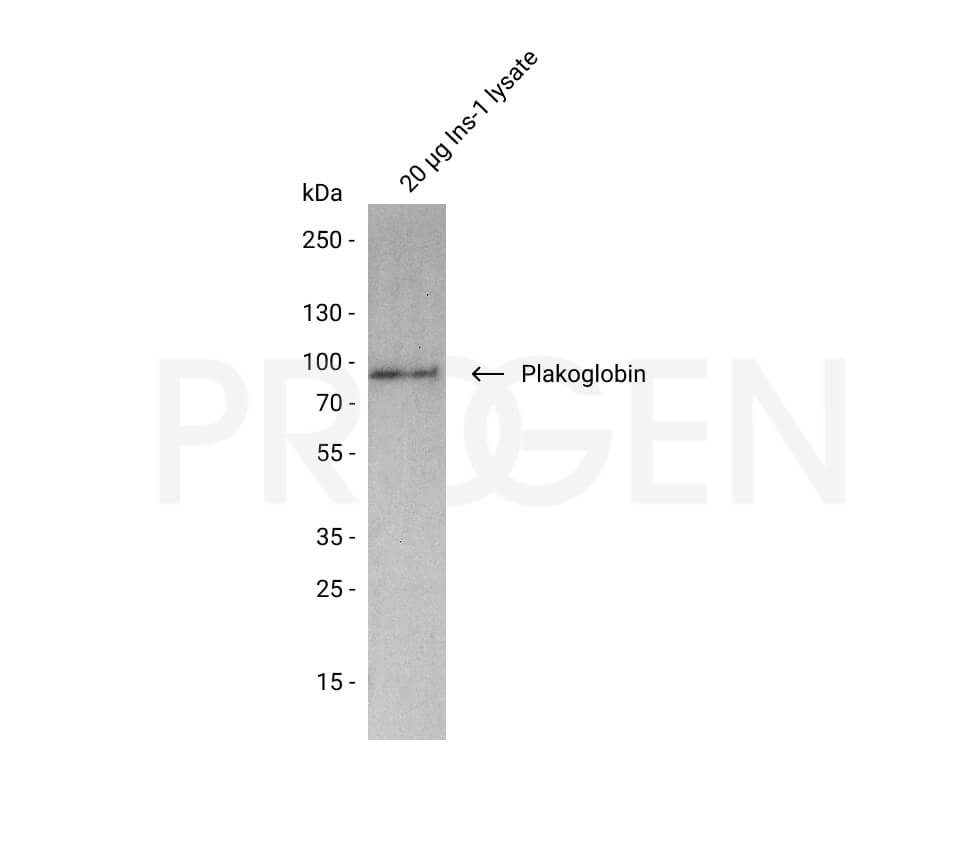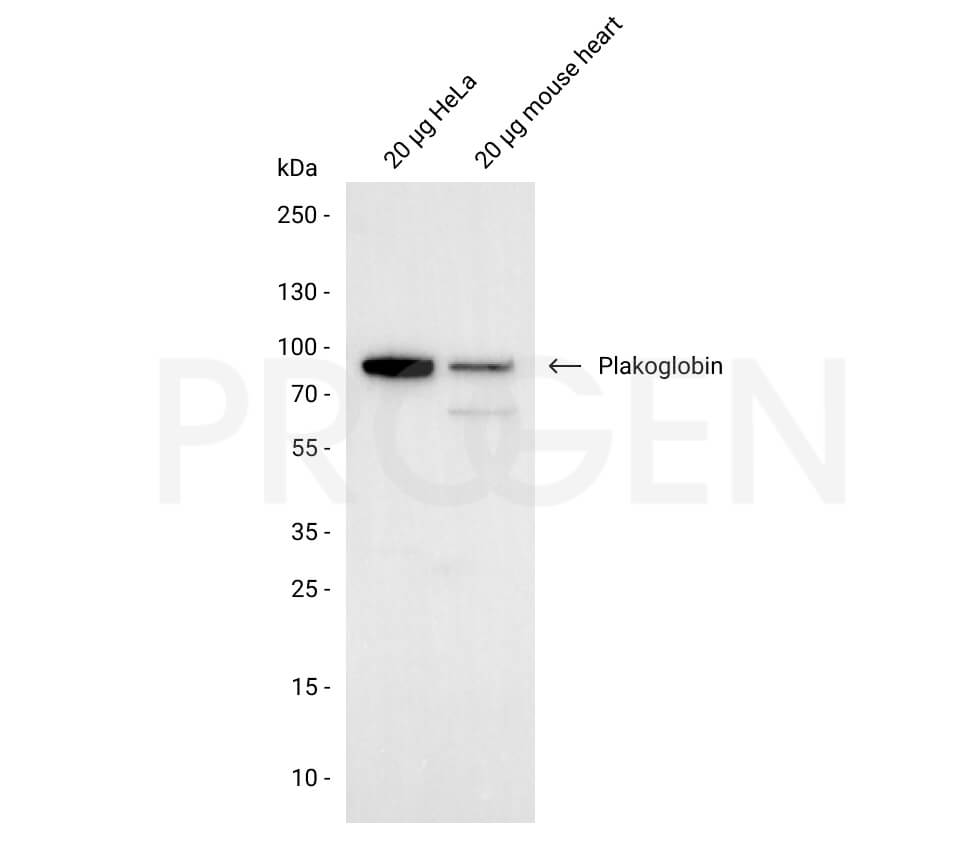anti-Plakoglobin mouse monoclonal, PG 5.1, liquid, purified, sample
- Mouse monoclonal
- Suitable for ICC/IF, IHC and WB
- Reacts with bovine, dog, human, mouse, rat and zebrafish
- Isotype: IgG2b
Product description
| Quantity | 200 µl |
|---|---|
| Antibody Type | Monoclonal |
| Host | Mouse |
| Isotype | IgG2b |
| Conjugate | Unconjugated |
| Application | ICC/IF, IHC, WB |
| Purification | Affinity chromatography |
| Reactivity | Bovine, Dog, Human, Mouse, Rat, Zebrafish |
| Storage | Short term at 2-8°C; long term storage in aliquots at -20°C; avoid freeze/thaw cycles |
| Intended use | Research use only |
| Clone | PG 5.1 |
| Immunogen | Plakoglobin, "band 5" protein from bovine snout epidermis |
| Concentration | 50 µg/ml (10 µg) |
| Formulation | PBS pH 7.4 with 0.09% sodium azide and 0.5% BSA |
Applications
| Tested applications | Tested dilutions |
|---|---|
| Immunocytochemistry (ICC)/ Immunofluorescence (IF) | 1:5 (10 µg/ml) |
| Immunohistochemistry (IHC) - frozen | 1:25-1:100 (0.5-2 µg/ml) |
| Immunohistochemistry (IHC) - paraffin | 1:25-1:100 (0.5-2 µg/ml, microwave treatment recommended) |
| Western Blot (WB) | 1:500-1:2,000 (0.025-0.1 µg/ml) |
Background
PG 5.1 represents an excellent marker for all forms of intercellular adhering junctions, such as: desmosomes of epithelial and myocardial cells (incl. cultured cells); zonulae and fasciae adherentes of epithelia, endothelia of blood vessels and myocardial cells; adherens-type junctions (e.g. lens tissue, pigmented retinal cells, Sertoli cells of testis). The PG 5.1 epitope maps within the C-terminus at the extreme end of repeat 13 (aa 632-687) of plakoglobin. Polypeptide reacting: Mr 83,000 Plakoglobin, 'band 5' polypeptide of intercellular adhering junctions (identical to gamma-catenin).
Reactivity on cultured cell lines: cell cultures forming monolayers.
References/Publications (20)
Downloads
Q & A's
Customer Reviews
Login
FAQs
The concentration of purified antibodies is mentioned on the datasheet.
For prediluted antibodies the concentration may vary from lot to lot. The concentration of these antibodies is not mentioned on the datasheet and can be requested at support@progen.com.
The supernatant format contains FCS proteins from cell culture medium supplemented with FCS.
The serum antibodies contain other proteins present in serum.
- Supernatant and supernatant concentrate: This format contains hybridoma cell culture supernatant. The antibody is not purified and the antibody concentration is not determined. The antibody concentration may vary from lot to lot. Therefore we recommend to titrate the optimal concentration for the application used for each new lot.
- Lyophilized, purified: This format contains purified antibody in lyophilized form. The reconstitution of this antibody is described in the datasheet. The buffer composition after reconstitution is also mentioned on the datasheet.
- Liquid, purified: This format contains purified antibody in liquid format. The concentration is mentioned on the datasheet.
- Prediluted, purified: This format contains purified antibody in liquid format. Most antibodies in this format are diluted to be ready-to-use for IHC with standard tissue. But some antibodies of this format need further dilution for IHC. This is mentioned on the datasheet.
Most of our liquid antibodies and reconstituted lyophilized antibodies may be stored for short term storage (up to 3 month) at 2-8°C. For long term storage we recommend to store the antibody at -20°C in aliquots. Please avoid freeze and thaw cycles.
Most of our conjugated antibodies should be stored at 2-8°C.
The individual storage conditions are mentioned on the datasheet.
- Homogenization of tissue in PBS (supplemented with protease inhibitors).
- Centrifugation at 10E4 x g.
- Optional: treat pellet with DNase.
- Resuspend pellet in detergent buffer (e.g. 1% Triton X-100), stir for 1 h at 2-8°C.
- Centrifugation at 10E4 x g.
- Resuspend pellet in high salt buffer (with 1.5 M KCl), stir for 1 h at 2-8°C.
- Centrifugation at 10E4 x g.
- Resuspend pellet in low salt buffer (e.g. 50 mM NaCl), stir for 30 min at 2-8°C.
- Centrifugation at 10E4 x g: pellet contains raw cytoskeletal fraction.
- Transfer from a low concentration acrylamide gel (e.g. 8%).
- Reduce the methanol concentration of the transfer buffer (limit is 50% of the routine concentration 20% methanol).
- Use the wet transfer method and transfer at least 4 h (or better overnight) at 100-200 mA.
- In order to prevent the accumulation of gas bubbles, stir the transfer buffer continuously during the transfer (e.g. with a magnetic stirrer).
- If possible use a cytoskeletal preparation of your material to be analyzed (in the case of cultured cells additionally DNase treatment) rather than whole cell lysate.
- As a general rule we would like to recommend loading that much protein into one gel lane that the intermediate filament polypeptides (in the 40-60 kD range) can be readily detected in a control gel stained with Coomassie blue.

